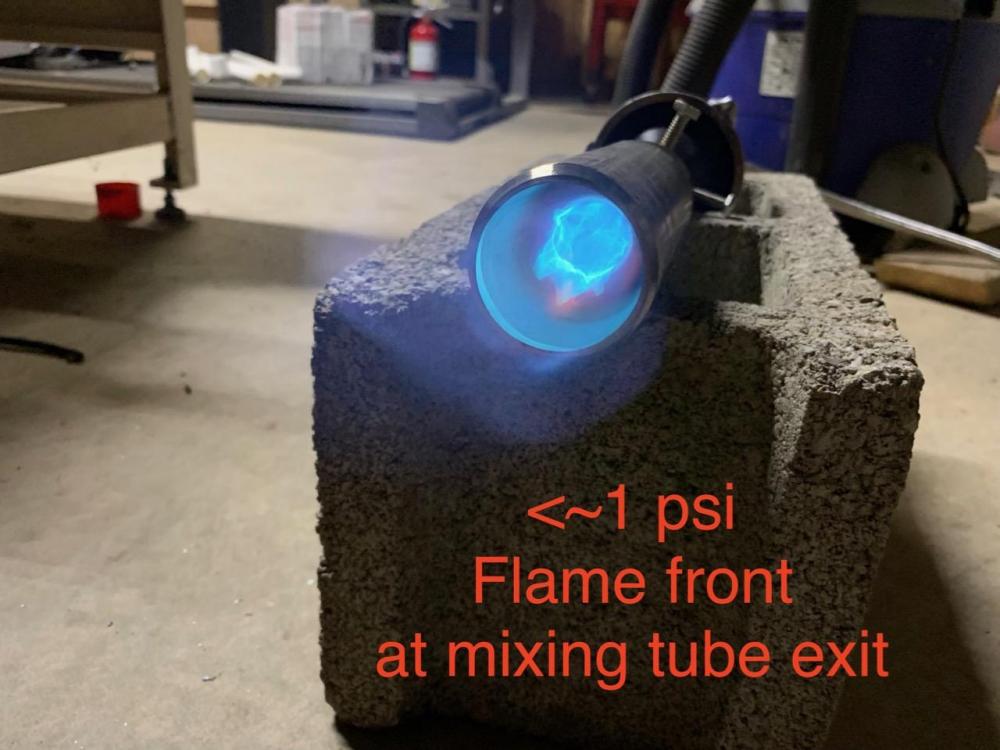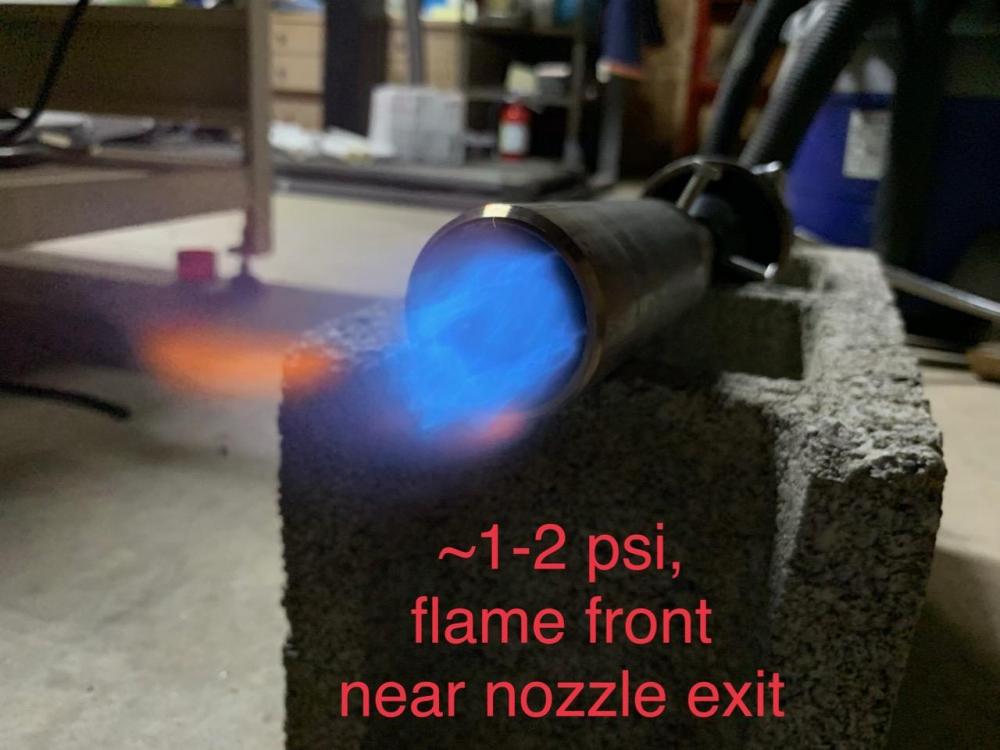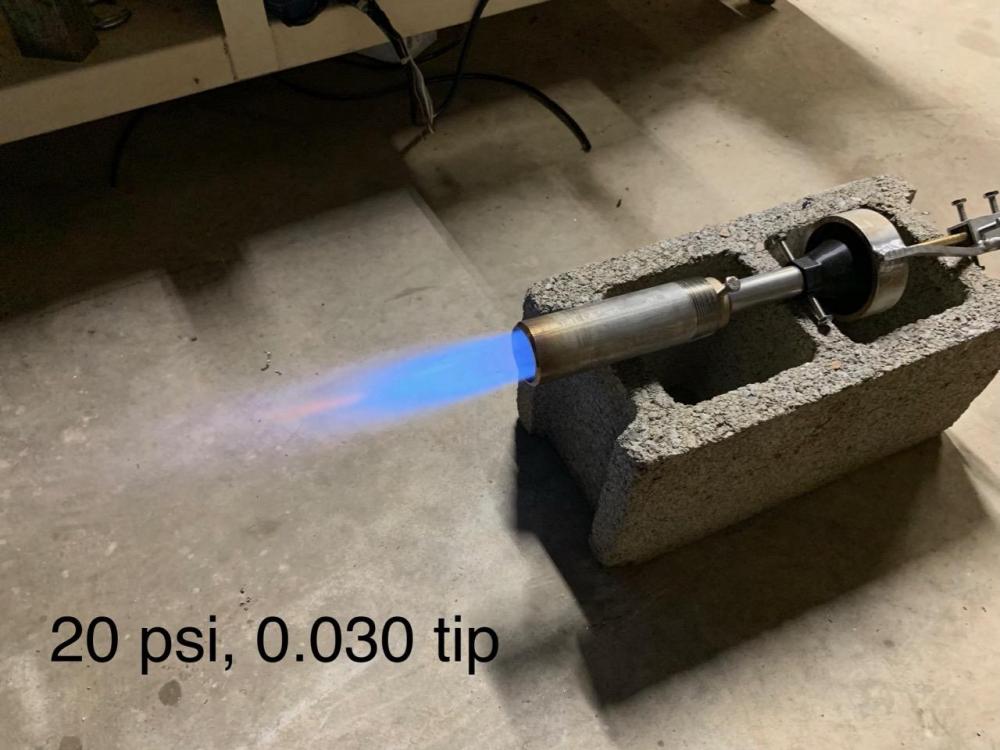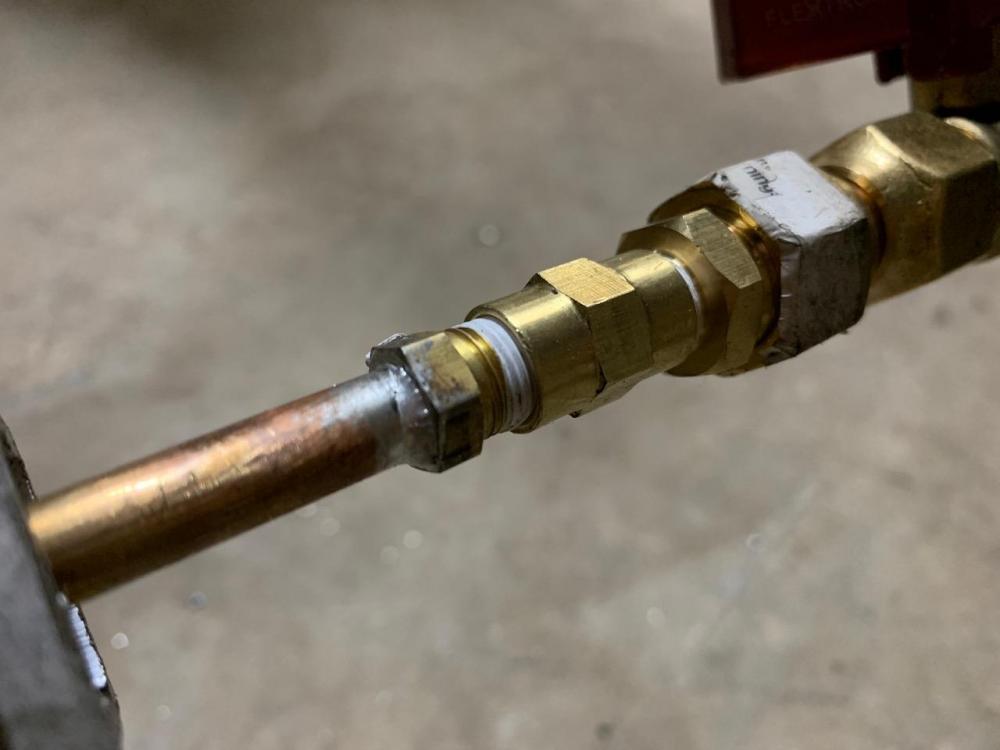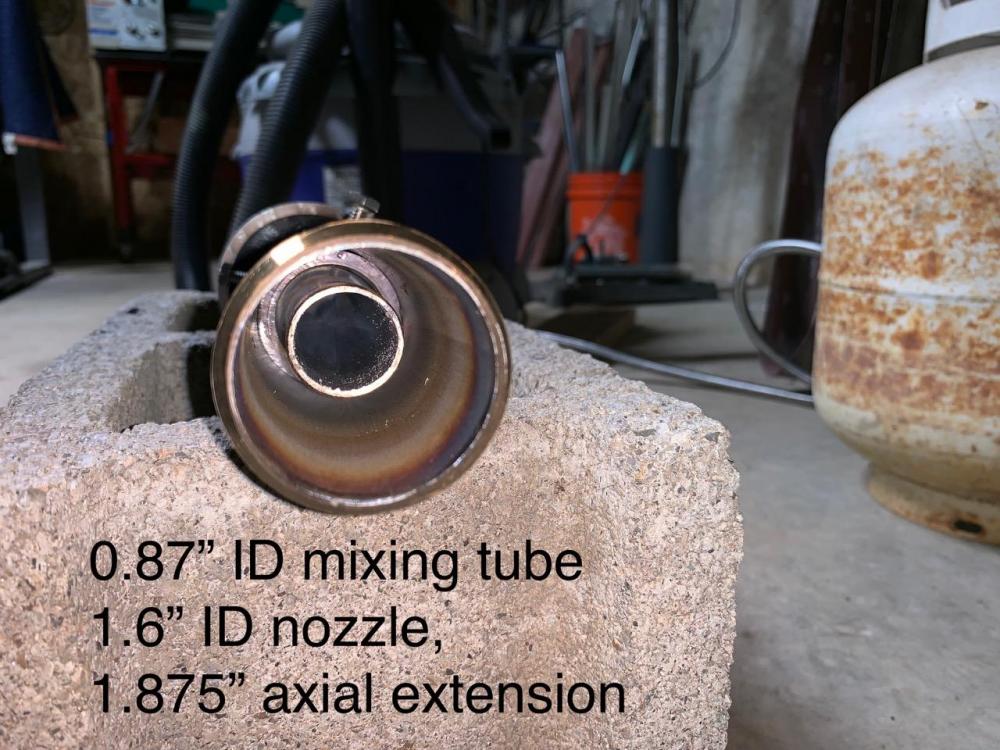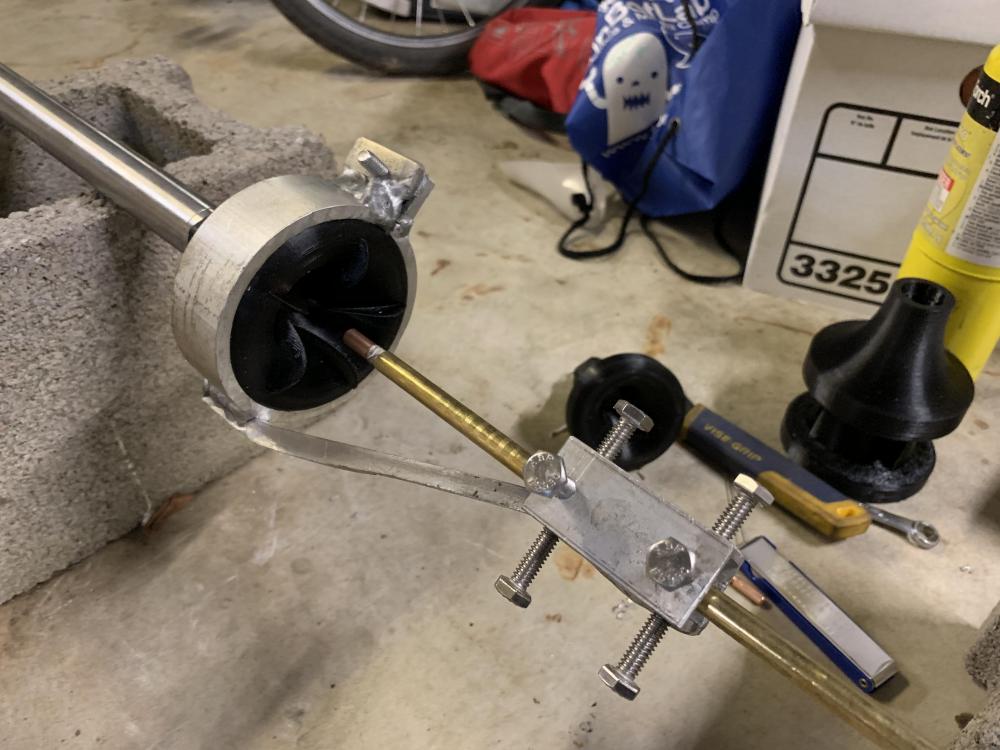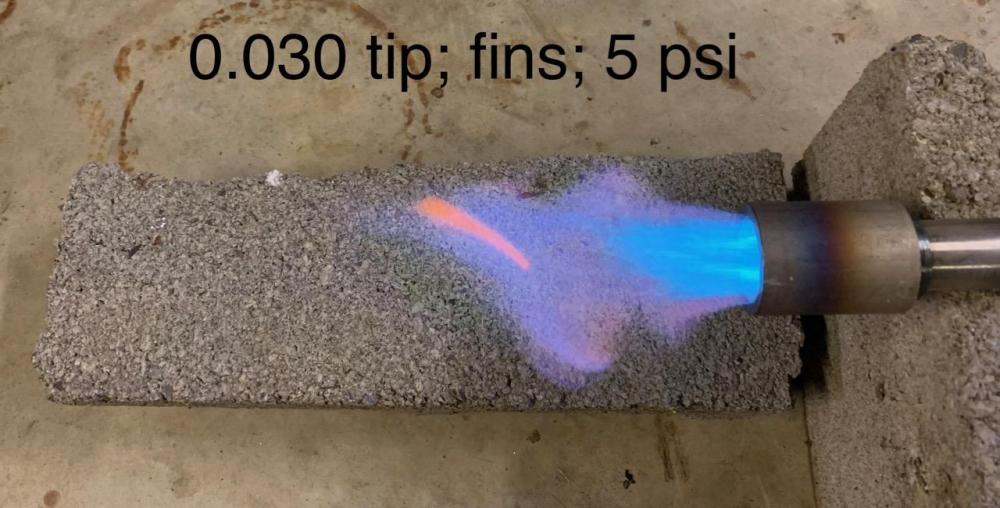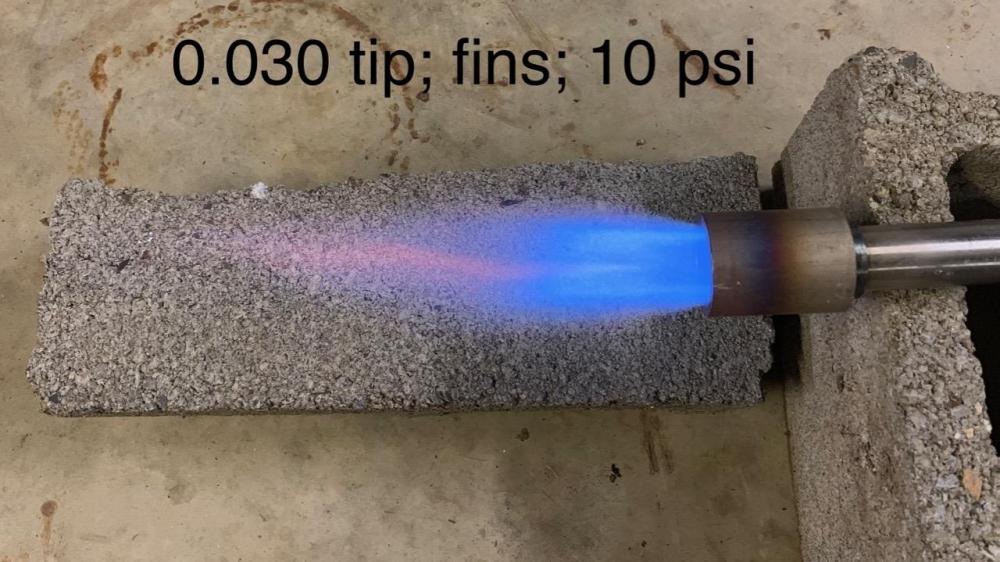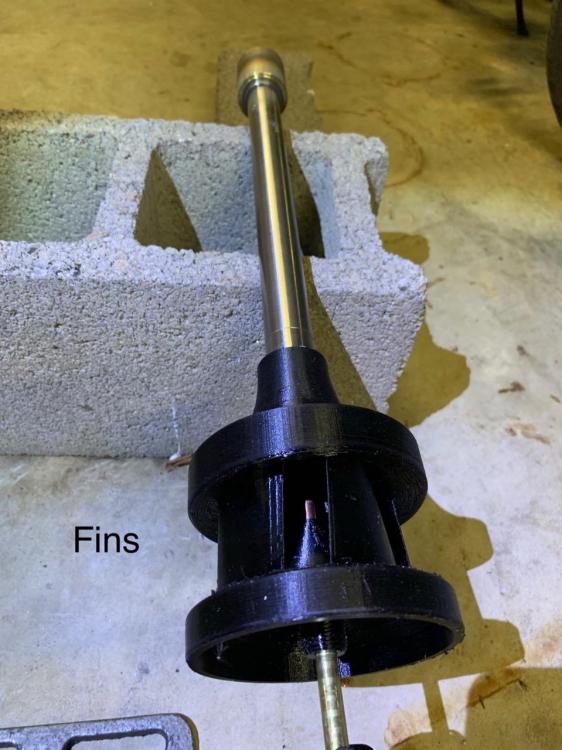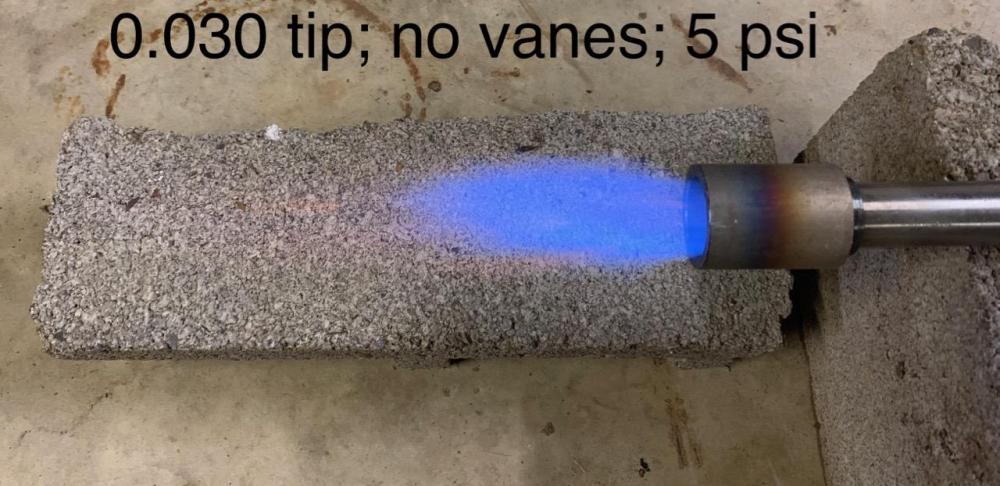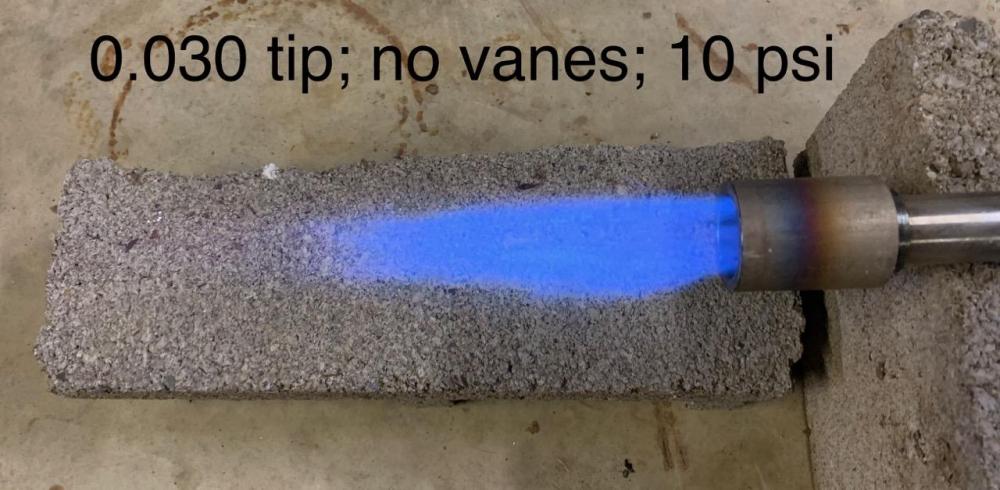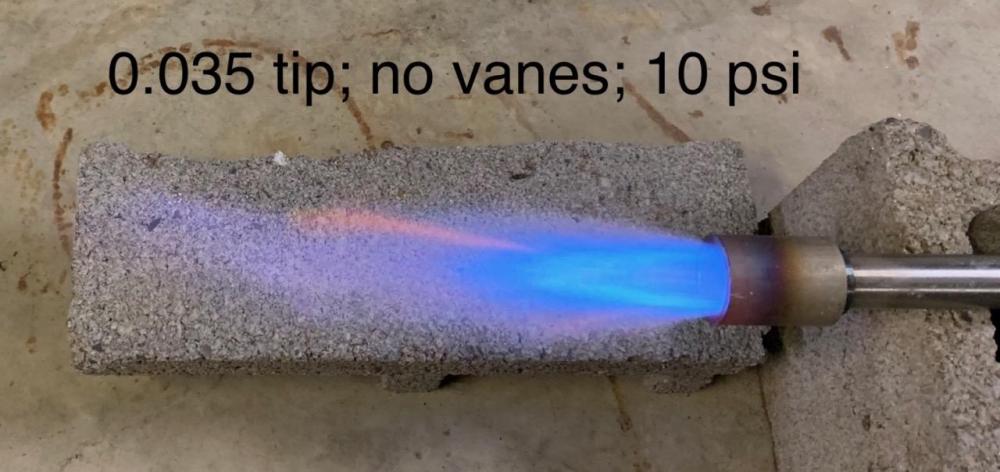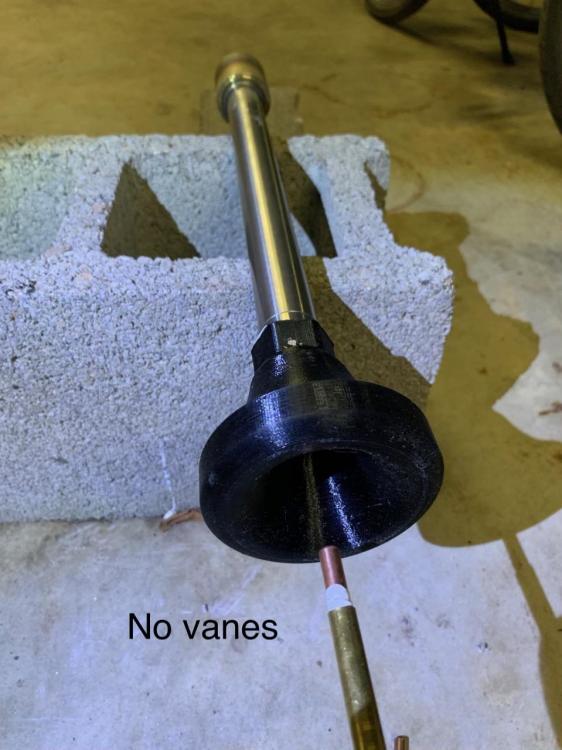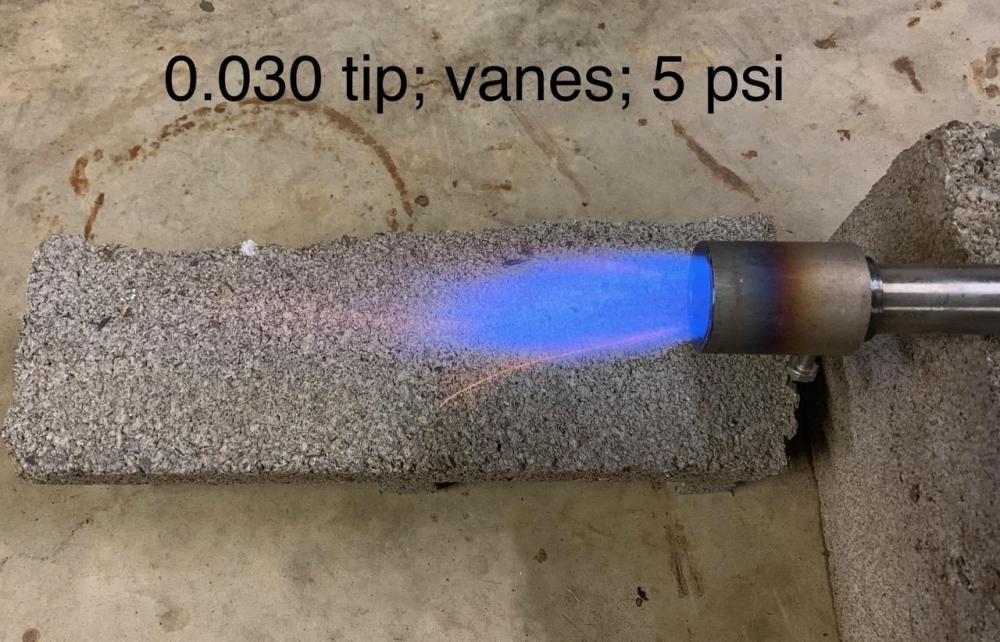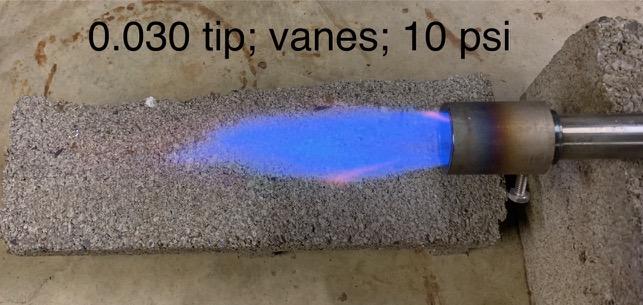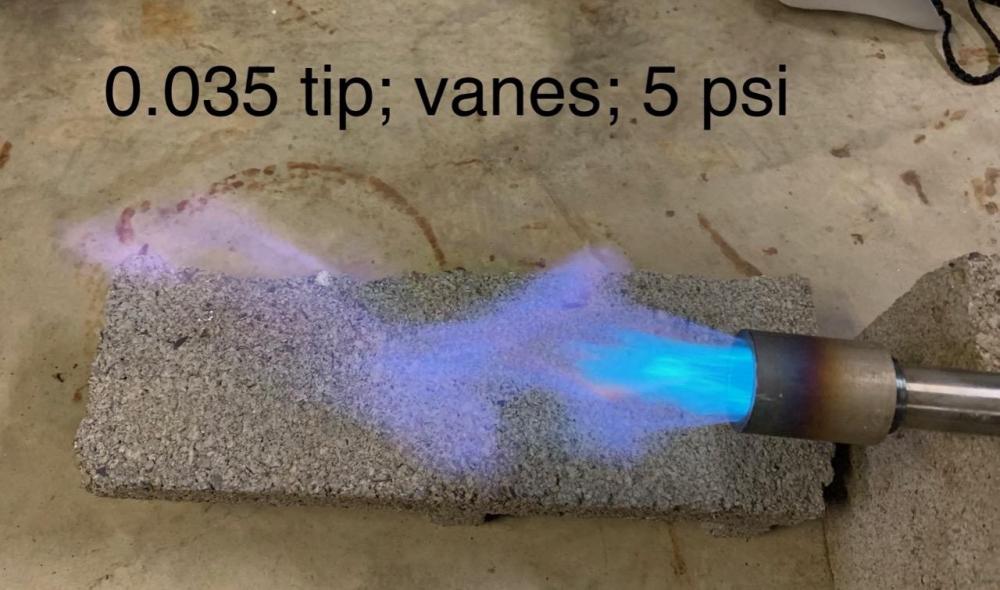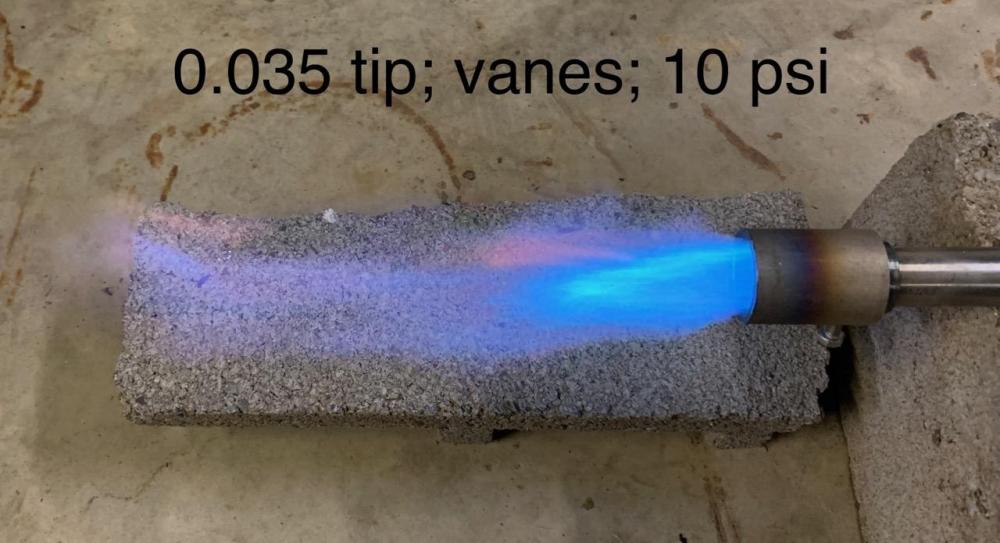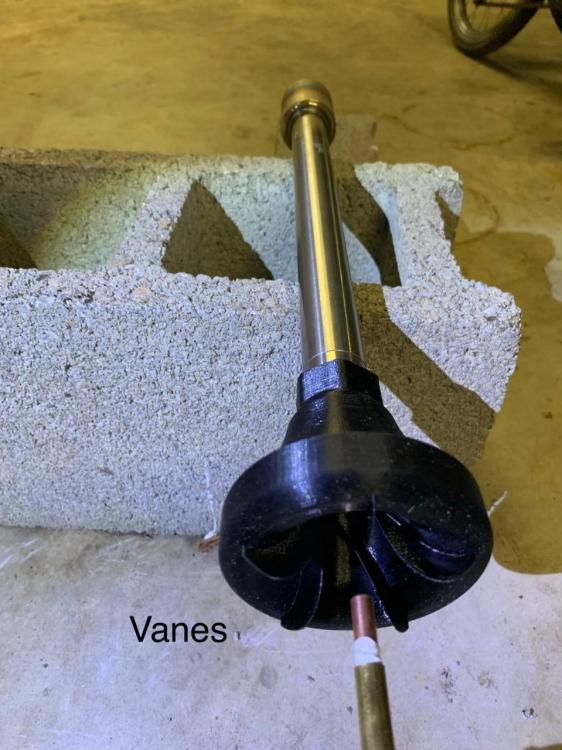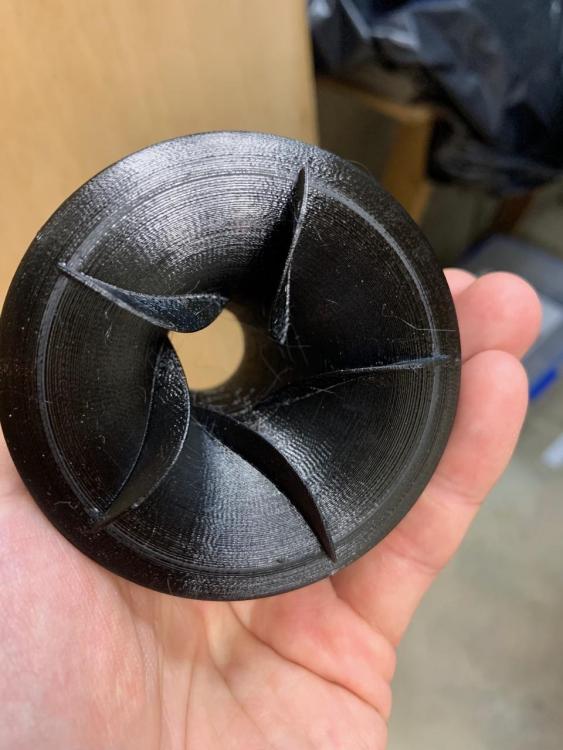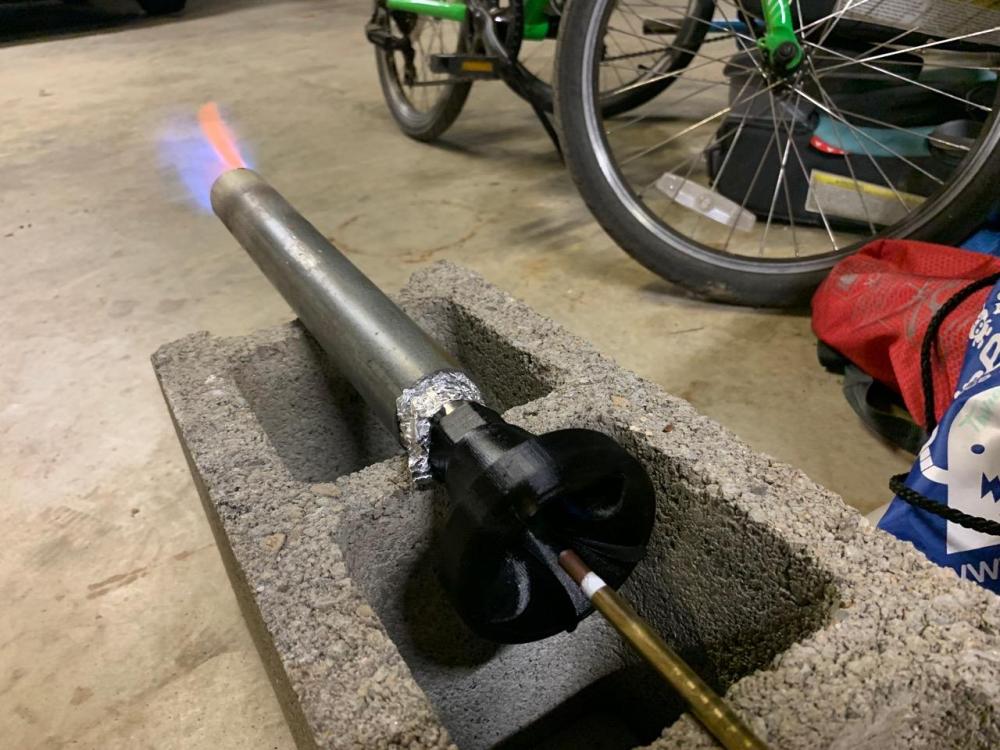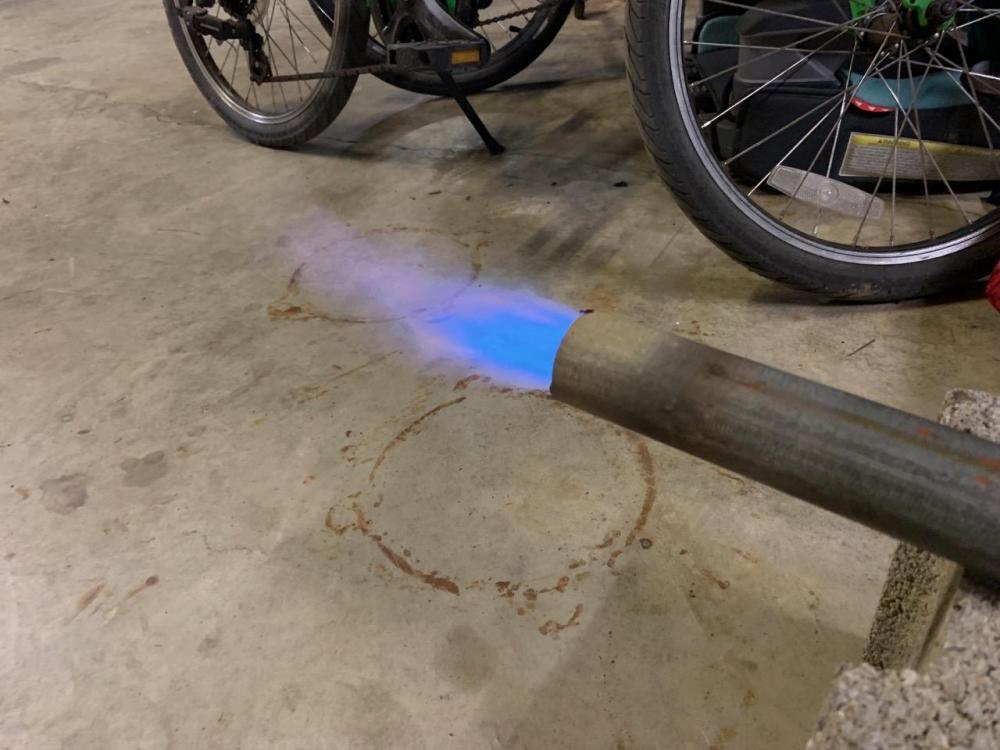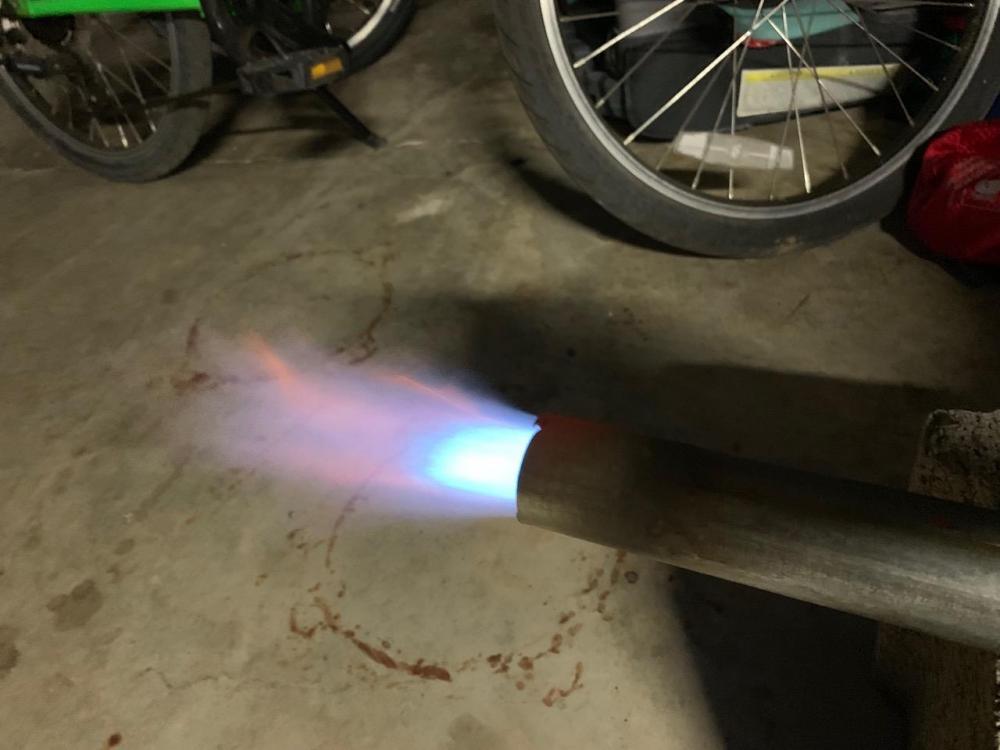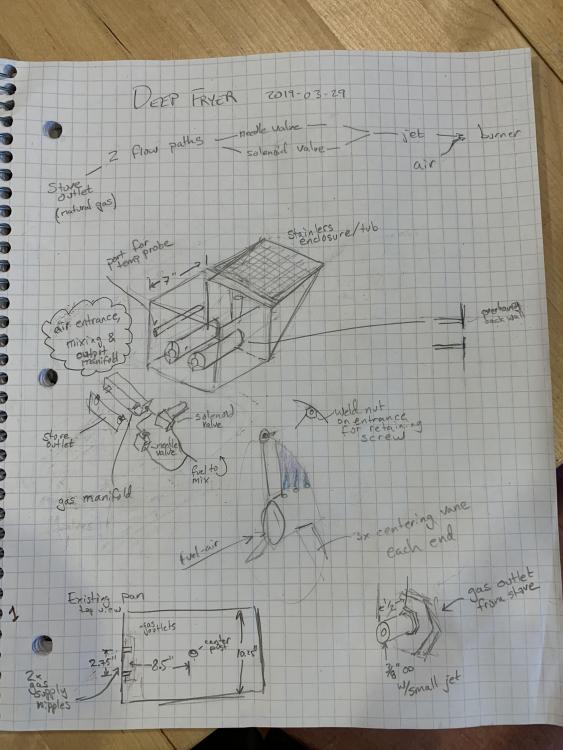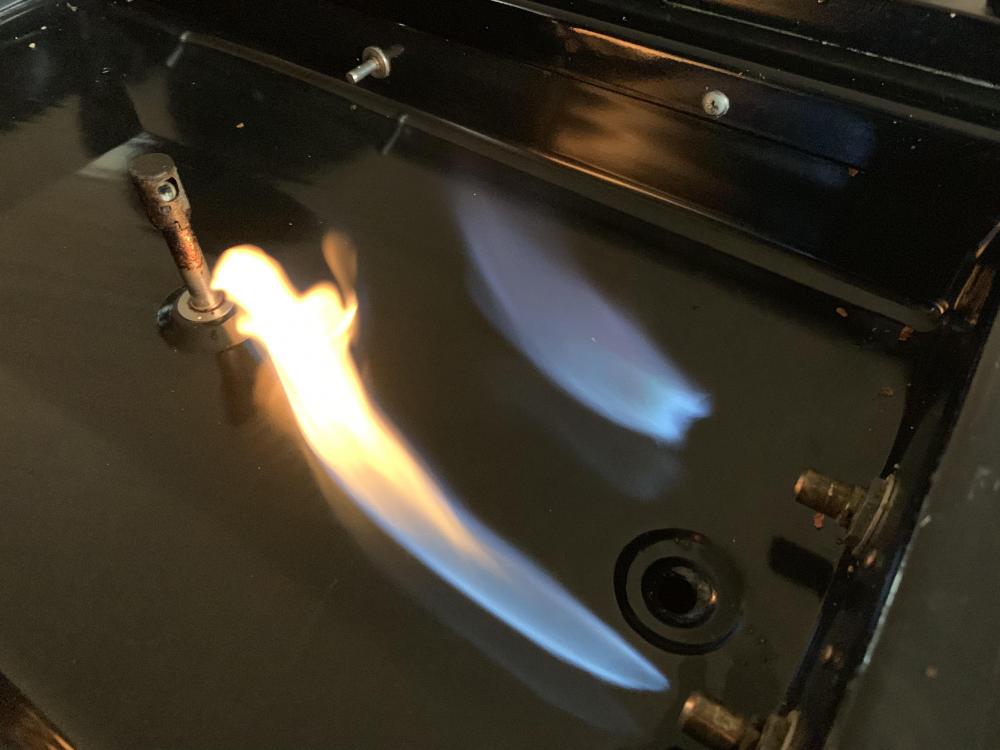
jwmelvin
Members-
Posts
117 -
Joined
-
Last visited
Content Type
Profiles
Forums
Articles
Gallery
Downloads
Events
Everything posted by jwmelvin
-
Can one of you experts explain the phenomenon where there is a low-pressure threshold, below which the flame front transitions from just inside the nozzle exit to right around the mixing-tube exit (and turns rich)? I guess it has to do with nonlinear air induction? Normal pressure (above ~1-2 psi): Very low pressure (below 1 psi): m With the larger nozzle, my burner lights easily when cold and seems pretty stable over 2-20 psi. I did change to a shorter mixing tube, which is steel tube that is 0.87" ID and 8" long (right around 9x ID); I didn't immediately notice a difference from the 0.93" ID, 12" long nozzle but didn't really compare. The nozzle is 1-1/2 sch 40 pipe (304 SS), so is 1.6" ID, and to get a stable flame requires it to extend past the end of the mixing tube about 1.9". Because I was just experimenting, the nozzle doesn't contact the mixing tube until well back of the mixing-tube exit, leaving a dead space around the exit. I'm not sure if how that affects flow. Any comment on the flame? I made the accelerator connection better by drilling into a plug and soldering it to the brass accelerator tube: Thanks for any thoughts.
-
Edit: I see that Mikey's nozzle based on sch 40 pipes would be an area that is 2.8x the area of the mixing tube. Mine is only 1.7x, so that could explain my flame blowing out. I will try a larger nozzle (seems like I want about 1.5" diameter).
-
Thank you; that's a good idea for aligning the accelerator tube. I got it roughly close but wasn't too careful. I will align this one but when I made the next version I will do something a little more precise and elegant. I do have more mixing tube coming so i can try some different lengths. I will also try a larger/longer nozzle. Why does a larger jet slow the FAM? I was thinking maybe the issue was not enough fuel, so the lean flame wasn't as robust, but it was a guess based on the richer flame from the larger jet having greater stability. A larger jet seems like it will induce about the same amount of air, but with more propane in the mix.
-
I made a frame to hold the accelerator. It still blows itself out with a 0.030 tip and runs rich with a .035 tip.
-
A little more info: This morning the flame was not stable (too lean) with a cold nozzle. I extended the nozzle as far as possible but it didn’t help. A 0.035 tip was stable but rich so I tried a tip cleaner on a 0.030 nozzle and now it is like the 0.035 nozzle. I guess I was too aggressive. I have another 0.030 tip but I can see I will have to get more. I may switch to hypodermic-tubing-based tips to have better control over the gas jet.
-
I made a real nozzle for my burner; it is stainless with the following dimensions: 1.224" ID; 1.375" length; step transition from 0.930" ID mixing tube that is 12" long. (That's a ~32% diameter expansion, or 73% area expansion; a half angle of 6.1 deg from the step to end of the nozzle ID.) I tested three configurations for the inducer: vanes, no vanes (plain bellmouth matching the shape of the vanes bellmouth), and fins (circumferential fins on the perimeter of the bellmouth, with a rear cone holding the accelerator): I tested each, starting with a 0.030 MIG tip (not the tapered kind). The vanes made the flame more stable but I think that's because the plain (no vanes) inducer was flowing faster. I did not experiment with the nozzle extension at all, but that also could help stabilize the plain inducer. I tried a 0.035 MIG tip on the accelerator as all of the flames seemed to be pretty lean (I could make them change by choking the inducer with my hand), but I'm pretty sure that the 0.035 tip was too big. The finned inducer ran a lot richer than the other two so I didn't spend much time with it. One thing I did notice was that the bellmouth inducers were not very sensitive to axial position of the accelerator nozzle. I do plan to taper the accelerator nozzle just for any bit of efficiency it can give. And i will make a frame that holds the accelerator in position. I'll put the pictures below and a video at the end; I appreciate any thoughts you may have on what aspects to try next. 5 psi 10 psi Thanks, -jason
-
Do you mean a blown RB or a NA? I was under the impression that the NA ones are a bit fussy so have started with a NA linear-injector burner. I do have a hot tub blower (and a couple old vacuums) I might be able to use for a blown burner... My first forge will be the five-gallon size you suggest. Any ideas on how to locate local suppliers for refractory materials? I’m in Northern Virginia and haven’t seen much from a couple web searches. There is a pottery supplier I need to call. I have a bunch of 2” Fiberfrax for a primary insulator.
-
That’s encouraging, thanks. It does have a nozzle (blew itself out without one) it’s just that the pipe I used for a nozzle is so long it swallowed the whole mixing tube. I’ll try to fashion a proper, adjustable flame nozzle and fixture the accelerator. I do have another inducer styled more like AFB’s to try too. Also: what is the downside to a mixing tube that is too long ?
-
That’s a good point, thanks. I do need a control. Especially since this is my first burner.
-
I made the first flame today. I have been thinking a bit on the 3d-printed bellmouth and came up with something I wanted to try, so I have that on the end of the thin 316 tube (12" long, 0.93" ID). I have a 0.030" MIG tip in a brass tube (threaded the end) that I'm just holding in the mouth of the possibly-vortex-generating inlet. And for a nozzle I grabbed a piece of pipe that is 1.375" ID and extends past the end of the mixing tube about 1.75". It was hastily assembled just to see if it would sustain a flame. I'll be building a frame to hold the propane nozzle centered in the right place, and I will make a flame nozzle. Here are some pictures at about 7psi (I believe the flame was about the same but the lighting changed between the two flame pics):
-
Thanks Mikey; that item from McMaster is $20, though their shipping tends to be more reasonable than most. (McMaster says there is a weld bead on the inside, which seems preferable to avoid.) McMaster's stainless tubing is about the same price, with a smooth bore. I ordered a piece of plain-steel tube from McMaster, 0.87" ID, 1.00" OD (0.065" wall); $3 for 1' or $7 for 3'. Thanks for the Amazon item AFB; I just ordered one of those too.
-
I appreciate your response, thank you. I definitely would not omit safety systems. This was primarily a mental exercise to consider the design parameters for the appropriate burner. Understood that it is out of scope for this forum/thread, but thank you again for the help. I will be building a burner for a forge/furnace, and will certainly be using the information here. I have some machine tools so will try to optimize my approach to the extent possible for a first timer. Do you think a 3/4" is a good size for first burner? I have an empty helium tank and an old propane tank I could use for a forge shell. I haven't given much thought to a furnace and really being able to cast may be a higher priority for me.
-
Yes I’ve read that. I don’t think there is so much risk, but regardless I am prepared to proceed. I was hoping for some general considerations regarding natural gas vs. propane burners. Maybe I should post in the NARB thread though?
-
Hi all. I’ve been reading around a bit in preparation of building my first burner. I would like a forge so I figure I will start with the burner. Then I was thinking that I’d like to build a deep fryer in my kitchen, using our existing natural-gas stove. So I am curious if you would guide me regarding my design considerations? I am thinking of two ribbons burning inside of cylindrical housings. I’m attaching a sketch of some ideas. Oh and I took a picture of the burning gas out straight out of the jets in case it tells you anything regarding scale of the burner I need. I think not, as they can flow a lot more gas; it just blows the flame out without proper air entrainment and mixing. Thanks, jason
-
Naturally Aspirated Ribbon Burner. Photo heavy.
jwmelvin replied to Frosty's topic in Ribbon Burners
This paper describes some investigation of the quench diameter for propane-air mixtures. Seems like 2.5-3mm is about the lower limit.
